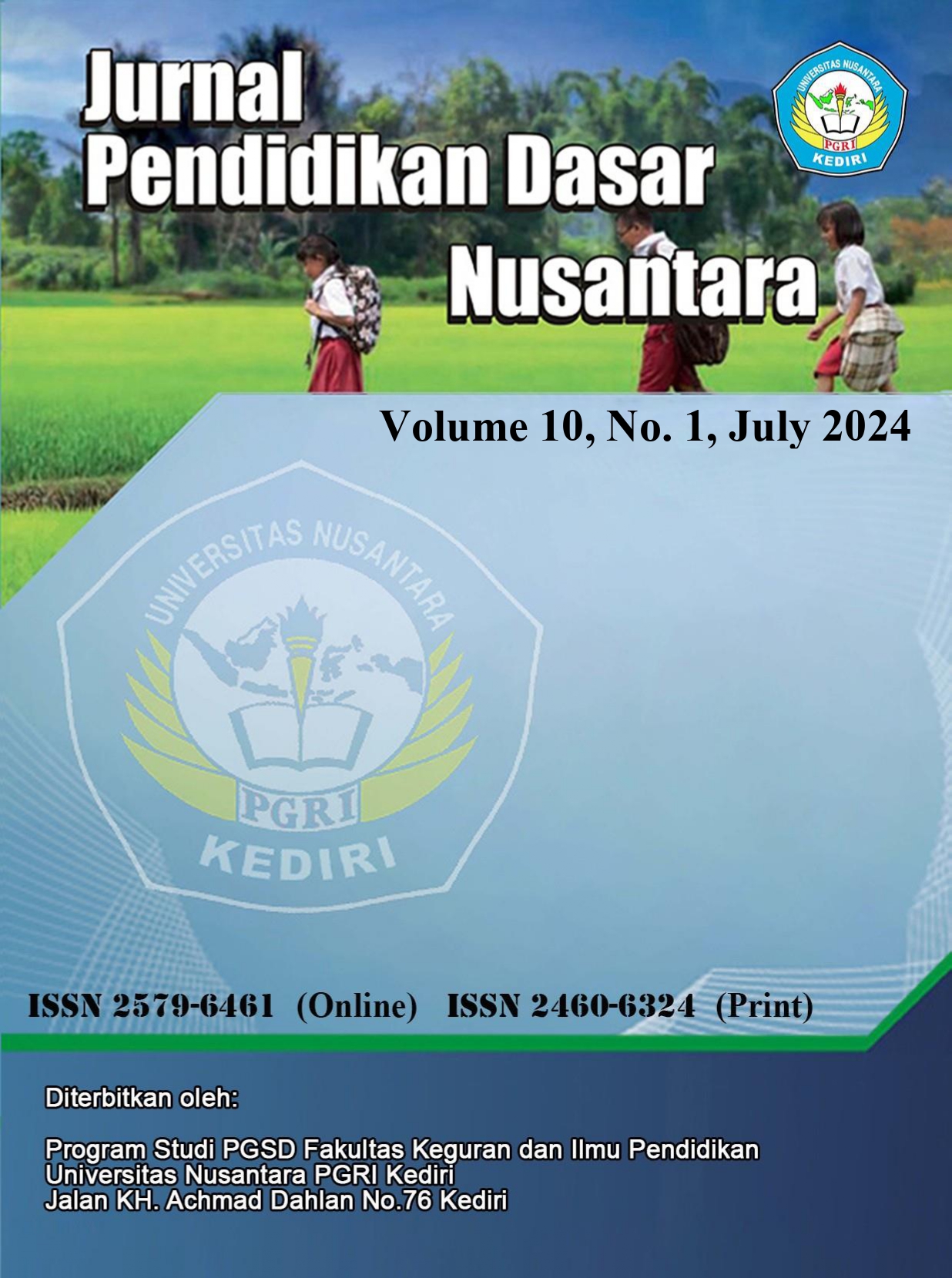Development of a Project Module for Strengthening Pancasila Student Profiles Containing Local Wisdom at SDN 6 Pempatan
DOI:
https://doi.org/10.29407/jpdn.v10i1.22582Keywords:
Module P5, Local Wisdom, Independent CurriculumAbstract
This study aims to determine the needs of educators and students in implementing the Pancasila Student Profile Strengthening Project activities, as well as the prototype and results of the validity test of the Pancasila Student Profile Strengthening Project module containing Local Wisdom. This study uses quantitative descriptive methods and descriptive statistics with a development research design to the product revision stage. There are 5 stages in this research design, starting from the potential and problem stages, data collection, product preparation, product validation, product revision from the validation results. The subjects of this study were educators and students of grade IV at SD N 6 Pempatan with the object of development in the form of the Pancasila Student Profile Strengthening Project Module containing Local Wisdom. The validation carried out by experts came from ITP Markandeya Bali Lecturers and Grade IV Homeroom Teachers at SD N 6 Pempatan, the validation of the Module was analyzed with descriptive statistics using a Likert scale. The module design was approved with several revisions, including adjusting the cover color, font type on the cover, adding a cover to the student worksheet (LKPD) that needed to be revised. The results obtained in the development research of the Pancasila Student Profile Strengthening Project Module Containing Local Wisdom are categorized as very valid from the results of the expert validation test with an average score of 131 from the interval scale that has been set. The difference between this development research and previous development research can be seen from the contents of the developed module, resulting in a difference in the module validation score. This is influenced by the module validation standards that are adjusted to the curriculum used.
Downloads
References
Aisyah, I. H., & Rinjani, D. (2023). Pengaruh Seni Ilustrasi dalam Meningkatkan Minat Baca (Studi Desain Novel Karya Tere Liye). Invensi, 8(1), 1–13. https://doi.org/10.24821/invensi.v8i1.7184
Ardianti, Y., & Amalia, N. (2022). Kurikulum Merdeka: Pemaknaan Merdeka dalam Perencanaan Pembelajaran di Sekolah Dasar. Jurnal Penelitian Dan Pengembangan Pendidikan, 6(3), 399–407. https://doi.org/10.23887/jppp.v6i3.55749
Di, K., Dasar, S., Susilawati, W. O., & Anggrayni, M. (2023). Pengembangan Modul P5 ( Proyek Penguatan Profil Pelajar Pancasila ) Fase B Tema. 3, 9799–9812.
Eni Astuti, N. P., Margunayasa, I. G., Suarni, N. K., Wirawan, I. P. H., & Sulastra, P. (2024). Permasalahan Asesmen Pada Kurikulum Merdeka. Cetta: Jurnal Ilmu Pendidikan, 7(1), 22–32. https://doi.org/10.37329/cetta.v7i1.2954
Erviana, Y., & Agus Faisal, V. I. (2022). Kearifan Lokal Lereng Sindoro-Sumbing dalam Membangun Profil Pancasila Anak Usia Dini. Jurnal Obsesi : Jurnal Pendidikan Anak Usia Dini, 6(6), 6909–6923. https://doi.org/10.31004/obsesi.v6i6.3501
Kemendikbud. (2021). Panduan Pengembangan Projek Penguatan Profil Pelajar Pancasila. Kementerian Pendidikan Dan Kebudayaan, 1–108. http://ditpsd.kemdikbud.go.id/hal/profil-pelajar-pancasila
Kusuma, I. K. N., Putu, N., Astuti, E., Putu, D., & Janawati, A. (2022). Analisis Implementasi Kurikulum Merdeka di SD Negeri 6 Pempatan. xx(April 2020), 1–14.
Maruti, S., Hanif, M., Budyartati, S., Huda, N., Kusuma, W., & Khoironi, M. (2023). Implementasi Projek Penguatan Profil Pelajar Pancasila (P5) pada Jenjang Sekolah Dasar. Abdimas Mandalika, 2(2), 85–90.
Maulinda, U. (2022). Pengembangan Modul Ajar Berbasis Kurikulum Merdeka. Tarbawi, 5(2), 130–138.
Maydiantoro, A. (2020). Model Penelitian Pengembangan. Chemistry Education Review (CER), 3(2), 185.
Ni Putu, E. A., Bagus Putu Arnyana, I., Nyoman Dantes, I., & Hendra Wirawan, I. P. (2023). “Santi Sarma” Implementasi Kebijakan Penggunaan Platform Merdeka Mengajar Menuju Guru Produktif Dan Inovatif. Pendas : Jurnal Ilmiah Pendidikan Dasar, 8(1), 196–209. https://doi.org/10.23969/jp.v8i1.7569
Numertayasa, I. W., Eni, N. P. A., Suardana, I. P. O., & Pradnyana, P. B. (2022). Workshop Review dan Implementasi Kurikulum Merdeka di SMP Negeri 3 Selemadeg Timur Pendahuluan. Madaniya, 3(3), 461–468. https://doi.org/https://doi.org/10.53696/27214834.236
Numertayasa, I. W., Kusuma, I. K. N., & Astuti, N. P. E. (2022). profil pelajar pancasila Development of Strengthening Character Education Syllabus Based on Pancasila Student Profiles. Jurnal Fundadikdas (Fundamental Pendidikan Dasar), 5(2), 97–108. https://doi.org/10.12928/fundadikdas.v5i2.6260
Nurasiah, I., Marini, A., Nafiah, M., & Rachmawati, N. (2022). Nilai Kearifan Lokal: Projek Paradigma Baru Program Sekolah Penggerak untuk Mewujudkan Profil Pelajar Pancasila. Jurnal Basicedu, 6(3), 3639–3648. https://doi.org/10.31004/basicedu.v6i3.2727
Pelajaran, M., Dasar, P., Siswa, U., Jurusan, K. X., Di, R., Krian, S., & 202, S. (n.d.). Pengembangan Media Pembelajaran Berbasis Video Animasi Pada. 379–383.
Rahmatih, A. N., Maulyda, M. A., & Syazali, M. (2020). Refleksi Nilai Kearifan Lokal (Local Wisdom) dalam Pembelajaran Sains Sekolah Dasar: Literature Review. Jurnal Pijar Mipa, 15(2), 151–156. https://doi.org/10.29303/jpm.v15i2.1663
Rajasa, P. G. A. (2022). Pengembangan Modul Pengenalan Karir untuk Siswa MTs. Jurnal Bimbingan Dan Konseling Islam, 12(1), 37–53. https://doi.org/10.29080/jbki.2022.12.1.37-53
Sugiyono. (2012). Metode Penelitian. Metode Penelitian, 37–54.
Suryandewi, N. W. R., & Suniasih, N. W. (2022). Buku Cerita Bergambar Dwibahasa Bali-Indonesia Berbasis Kearifan Lokal Pembelajaran Bahasa Bali Materi Satua Bali Kelas V Sekolah Dasar. MIMBAR PGSD Undiksha, 10(1), 84–93. https://doi.org/10.23887/jjpgsd.v10i1.44585
Downloads
Published
Issue
Section
License
Authors who publish with this journal agree to the following terms:
- Copyright on any article is retained by the author(s).
- The author grants the journal, the right of first publication with the work simultaneously licensed under a Creative Commons Attribution License that allows others to share the work with an acknowledgment of the work’s authorship and initial publication in this journal.
- Authors are able to enter into separate, additional contractual arrangements for the non-exclusive distribution of the journal’s published version of the work (e.g., post it to an institutional repository or publish it in a book), with an acknowledgment of its initial publication in this journal.
- Authors are permitted and encouraged to post their work online (e.g., in institutional repositories or on their website) prior to and during the submission process, as it can lead to productive exchanges, as well as earlier and greater citation of published work.
- The article and any associated published material is distributed under the Creative Commons Attribution-ShareAlike 4.0 International License

































